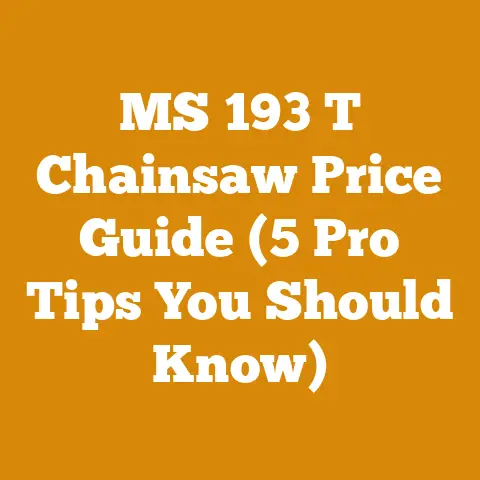Parts for a McCulloch Chainsaw (5 Expert Tips for Easy Restoration)
Imagine your McCulloch chainsaw as a classic car, perhaps a vintage Mustang.
It’s got that raw power, that iconic look, but years of hard work (or neglect) can take their toll.
Just like that Mustang needs a tune-up and maybe some new parts to roar back to life, your McCulloch chainsaw might be craving some TLC.
Replacing worn-out or broken parts isn’t just about fixing a machine; it’s about resurrecting a piece of history and ensuring it continues to serve you well for years to come.
In this article, I’ll share my expert tips for easy McCulloch chainsaw restoration, focusing on the crucial parts you’ll likely need and how to navigate the often-murky waters of pricing and availability.
Parts for a McCulloch Chainsaw: 5 Expert Tips for Easy Restoration
Restoring a McCulloch chainsaw can be a rewarding experience, but it requires careful planning and a good understanding of the parts involved.
I’ve spent years tinkering with chainsaws, from the old workhorses to the modern marvels, and I’ve learned a thing or two about what works and what doesn’t.
In this guide, I’ll walk you through the essential parts you might need, how to source them, and how to save money along the way.
1. Identifying Your McCulloch Chainsaw Model
Before you even think about ordering parts, you must know your chainsaw’s exact model number.
This is absolutely crucial.
Just like you wouldn’t try to put a Ford engine in a Chevy, you can’t expect parts from one McCulloch model to fit another.
The model number is usually found on a sticker or stamped directly onto the chainsaw’s body, often near the engine or on the side.
Why is this so important?
- Compatibility: Different models have different designs and dimensions.
A part that fits a McCulloch Mac 10-10 might be completely wrong for a McCulloch Pro Mac 610. - Availability: Knowing the exact model helps you narrow down your search for parts, increasing the chances of finding what you need.
- Accuracy: Using the correct model number ensures you order the right parts the first time, saving you time, money, and frustration.
My Personal Experience:
I once made the mistake of ordering a carburetor for what I thought was a Mac 10-10.
Turns out, it was a slightly different variant – a Mac 10-10A.
The carb looked almost identical, but the bolt pattern was just a hair off.
I ended up having to return it and start all over.
Lesson learned: always double-check the model number!
2. Essential Parts for McCulloch Chainsaw Restoration
Let’s dive into the most common parts you’ll likely need for your McCulloch chainsaw restoration project.
a. Chains and Bars
The chain and bar are the workhorses of your chainsaw.
They’re responsible for cutting through wood, and they take a beating.
Over time, they wear down, become dull, or even break.
- Chains: Chains come in various lengths, pitches, and gauges.
The pitch refers to the distance between the chain’s drive links, while the gauge refers to the thickness of the drive links.
You need to match the chain’s pitch and gauge to your chainsaw’s bar.
A new chain can cost anywhere from $20 to $50, depending on the size and quality. - Bars: The bar guides the chain and supports it as it cuts.
Bars also come in different lengths and widths.
A worn or damaged bar can cause the chain to bind or even come off, making it dangerous to use.
A new bar can cost anywhere from $30 to $80, depending on the length and quality.
Cost Factors:
- Chain Quality: Higher-quality chains made from better steel will last longer and stay sharper.
- Bar Length: Longer bars are more expensive than shorter bars.
- Brand: Some brands, like Oregon, are known for their quality and durability, but they also tend to be more expensive.
My Tip: Invest in a good-quality chain.
It’ll save you money in the long run because it’ll last longer and require less frequent sharpening.
b. Carburetors and Fuel Lines
The carburetor is responsible for mixing air and fuel in the correct proportions to create a combustible mixture.
Over time, carburetors can become clogged with dirt and debris, leading to poor performance or even a complete failure to start.
Fuel lines can also become brittle and crack, causing fuel leaks.
- Carburetors: A new carburetor can cost anywhere from $20 to $100, depending on the model and complexity.
Rebuilding a carburetor with a carburetor kit is also an option and can save you money.
A carburetor kit typically costs around $10 to $30. - Fuel Lines: Replacing fuel lines is a relatively simple and inexpensive task.
Fuel lines typically cost around $5 to $10 per foot.
Cost Factors:
- Carburetor Complexity: More complex carburetors with more features will be more expensive.
- Brand: Aftermarket carburetors are often cheaper than OEM (Original Equipment Manufacturer) carburetors.
- Rebuild vs.
Replace: Rebuilding a carburetor can be cheaper than replacing it, but it requires more time and effort.
My Story:
I once had a McCulloch chainsaw that refused to start, no matter what I did.
I cleaned the spark plug, checked the fuel, and even tried starting fluid.
Nothing worked.
Finally, I decided to take a closer look at the carburetor.
It was completely gummed up with old fuel and varnish.
I bought a carburetor kit, carefully disassembled the carburetor, cleaned all the parts, and reassembled it with the new kit.
To my surprise, the chainsaw started right up!
It was a satisfying feeling to bring that old machine back to life.
c. Ignition Coils and Spark Plugs
The ignition coil is responsible for generating the high-voltage spark that ignites the air-fuel mixture in the engine.
Spark plugs provide the gap across which the spark jumps to ignite the fuel.
Over time, ignition coils can fail, leading to a weak or nonexistent spark.
Spark plugs can also become fouled with carbon deposits, preventing them from firing properly.
- Ignition Coils: A new ignition coil can cost anywhere from $20 to $50, depending on the model.
- Spark Plugs: Spark plugs are relatively inexpensive, typically costing around $5 to $10 each.
Cost Factors:
- OEM vs. Aftermarket: Aftermarket ignition coils are often cheaper than OEM coils.
- Spark Plug Type: Different types of spark plugs are available, with some offering better performance or longer life.
My Advice:
Always use the correct type of spark plug for your McCulloch chainsaw.
Using the wrong spark plug can damage the engine.
d. Air Filters
The air filter prevents dirt and debris from entering the engine.
A clogged air filter can restrict airflow, leading to poor performance and even engine damage.
Air filters are relatively inexpensive and easy to replace.
They typically cost around $5 to $15.
Cost Factors:
- Filter Type: Different types of air filters are available, with some offering better filtration than others.
- Reusable vs.
Disposable: Some air filters are reusable and can be cleaned, while others are disposable and need to be replaced.
My Recommendation:
Clean or replace your air filter regularly to keep your McCulloch chainsaw running smoothly.
e. Starters and Recoil Springs
The starter is used to crank the engine and get it running.
The recoil spring is responsible for retracting the starter rope.
Over time, starters can break, and recoil springs can lose their tension.
- Starters: A new starter can cost anywhere from $30 to $80, depending on the model.
- Recoil Springs: A new recoil spring typically costs around $10 to $20.
Cost Factors:
- Starter Complexity: More complex starters with more features will be more expensive.
- OEM vs. Aftermarket: Aftermarket starters are often cheaper than OEM starters.
My Experience:
I once had a McCulloch chainsaw with a broken starter.
I tried to repair it myself, but I ended up making things worse.
I ended up buying a new starter, and it was a relatively easy installation.
f. Oil Pumps
The oil pump is responsible for lubricating the chain and bar.
A malfunctioning oil pump can cause the chain and bar to overheat and wear out quickly.
A new oil pump can cost anywhere from $20 to $60, depending on the model.
Cost Factors:
- Pump Type: Different types of oil pumps are available, with some offering better performance than others.
- OEM vs. Aftermarket: Aftermarket oil pumps are often cheaper than OEM pumps.
My Advice:
Check your oil pump regularly to ensure it’s working properly.
If you notice that your chain and bar are not being properly lubricated, replace the oil pump immediately.
3. Finding Parts: Online Retailers, Local Shops, and Salvage Yards
Now that you know what parts you need, let’s talk about where to find them.
You have several options:
- Online Retailers: Online retailers like Amazon, eBay, and chainsaw-specific websites are a great place to start your search.
They offer a wide selection of parts at competitive prices. - Local Shops: Local chainsaw repair shops and hardware stores can also be a good source for parts.
They may not have as wide a selection as online retailers, but they can offer expert advice and assistance. - Salvage Yards: Salvage yards can be a great place to find used parts at a fraction of the cost of new parts.
However, you’ll need to be prepared to do some searching and cleaning.
My Strategy:
I usually start my search online to get an idea of prices and availability.
Then, I check with my local chainsaw repair shop to see if they have the parts I need.
If I’m on a tight budget, I’ll consider checking out a salvage yard.
Cost-Saving Tip:
Consider buying used parts whenever possible.
Used parts can be just as good as new parts, and they’re often much cheaper.
Just be sure to inspect the parts carefully before you buy them to make sure they’re in good condition.
4. Budgeting for Your McCulloch Chainsaw Restoration
Restoring a McCulloch chainsaw can be an expensive undertaking.
It’s important to create a budget before you start your project so you don’t overspend.
Here’s how to create a budget:
- Identify the Parts You Need: Make a list of all the parts you need to replace.
- Research Prices: Research the prices of the parts you need from different sources.
- Estimate Labor Costs: If you’re not comfortable doing the repairs yourself, get estimates from local chainsaw repair shops.
- Add a Contingency: Add a contingency of 10-20% to your budget to cover unexpected expenses.
Cost-Cutting Strategies:
- Do the Repairs Yourself: If you’re comfortable doing the repairs yourself, you can save a lot of money on labor costs.
- Buy Used Parts: As mentioned earlier, buying used parts can save you a significant amount of money.
- Shop Around: Don’t just buy the first part you find.
Shop around to compare prices from different sources. - Prioritize Repairs: Focus on repairing the most essential parts first.
You can always address less critical repairs later.
Real-World Cost Example:
Let’s say you need to replace the chain, bar, carburetor, and air filter on your McCulloch chainsaw.
Here’s a possible breakdown of the costs:
- Chain: $30
- Bar: $50
- Carburetor: $60
- Air Filter: $10
Total Parts Cost: $150
If you’re doing the repairs yourself, your total cost will be $150.
If you’re hiring a chainsaw repair shop, you’ll need to add labor costs, which could range from $50 to $100 or more, depending on the complexity of the repairs.
My Budgeting Experience:
I once restored a McCulloch Pro Mac 610 that had been sitting in my garage for years.
I knew it needed some work, but I wasn’t prepared for the extent of the repairs.
I ended up spending over $200 on parts, including a new carburetor, ignition coil, and chain.
However, I was able to do all the repairs myself, so I saved a lot of money on labor costs.
In the end, it was worth it to bring that old chainsaw back to life.
5. Expert Tips for Easy McCulloch Chainsaw Restoration
Here are some final expert tips to help you with your McCulloch chainsaw restoration project:
- Clean Everything: Before you start working on your chainsaw, clean it thoroughly.
This will make it easier to identify problems and work on the parts. - Take Pictures: Take pictures of everything as you disassemble the chainsaw.
This will help you remember how everything goes back together. - Use the Right Tools: Use the right tools for the job.
Using the wrong tools can damage the parts or make the repairs more difficult. - Follow the Instructions: Follow the instructions in the service manual carefully.
- Be Patient: Restoring a McCulloch chainsaw can take time.
Be patient and don’t get discouraged if you run into problems.
Specific Tips for Common Issues:
- Hard Starting: If your chainsaw is hard to start, check the spark plug, carburetor, and fuel lines.
- Poor Performance: If your chainsaw is running poorly, check the air filter, spark plug, and carburetor.
- Chain Binding: If the chain is binding, check the bar and chain for damage.
- Fuel Leaks: If you notice fuel leaks, check the fuel lines and fuel tank for cracks or damage.
Safety First:
Always wear safety glasses, gloves, and hearing protection when working on your chainsaw.
Disconnect the spark plug wire before you start working on the engine to prevent accidental starting.
Global Considerations:
- Part Availability: Part availability can vary depending on your location.
Some parts may be more difficult to find in certain countries. - Pricing: Pricing can also vary depending on your location.
Parts may be more expensive in some countries due to import duties and other factors. - Language Barriers: If you’re ordering parts online from a foreign country, be aware of potential language barriers.
My Final Thoughts:
Restoring a McCulloch chainsaw can be a challenging but rewarding experience.
With careful planning, a good understanding of the parts involved, and a little bit of elbow grease, you can bring that old machine back to life and enjoy it for years to come.
Just remember to be patient, take your time, and always prioritize safety.
And don’t be afraid to ask for help if you need it.
There are plenty of experienced chainsaw mechanics and enthusiasts out there who are willing to share their knowledge.
Actionable Takeaways:
- Identify your exact McCulloch chainsaw model. This is the most crucial step.
- Prioritize essential parts: Focus on chain, bar, carburetor, ignition, and air filter.
- Shop around: Compare prices from online retailers, local shops, and salvage yards.
- Create a budget: Estimate costs and add a contingency for unexpected expenses.
- Safety first: Always wear protective gear and disconnect the spark plug before working on the chainsaw.
By following these tips, you’ll be well on your way to restoring your McCulloch chainsaw and enjoying the satisfaction of bringing a piece of history back to life.
Now, go out there and get your hands dirty!
You might even find yourself with a newfound appreciation for the ingenuity and durability of these classic machines.
Good luck, and happy sawing!






